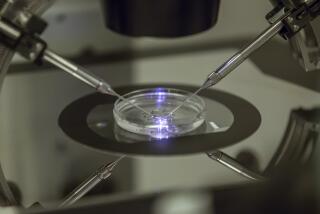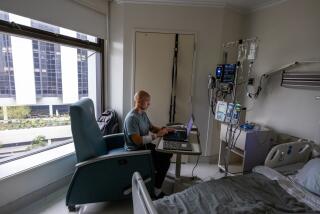Bone marrow transplant ‘gets rid of’ sickle cell anemia
Researchers have for the first time performed a successful bone marrow transplant to cure sickle cell disease in adults, a feat that could expand the procedure to more of the 70,000 Americans with the disease -- and possibly some other diseases as well.
About 200 children have been cured of sickle cell with transplants, but the procedure was considered too harsh for adults with severe sickle cell disease. Now a team from the National Institutes of Health and Johns Hopkins University is reporting today in the New England Journal of Medicine that it has developed a much-less-toxic transplant procedure and used it to cure nine of the first 10 patients studied.
“We really don’t have anything else to offer patients with sickle cell disease” who do not respond to hydroxyurea, the only drug useful in treating it, said the paper’s senior author, Dr. John F. Tisdale of the National Heart, Lung and Blood Institute. “It’s really satisfying to perform a therapy that . . . gets rid of the disease.”
Dr. Kwaku Ohene-Frempong of the Children’s Hospital of Philadelphia agreed: “This is very significant . . . because it opens up the opportunity for adults to be considered for transplantation.”
The main problem is that not enough sickle cell patients have a healthy sibling who is a compatible donor. A sibling donor is normally necessary in sickle-cell transplants to ensure that the patient doesn’t reject the new marrow. The team plans to try using unrelated donors and parents.
Sickle cell disease, which affects primarily people of African descent, is caused by a genetic mutation that gives red blood cells a sickle shape, hindering their ability to carry oxygen and causing them to clog blood vessels. It can cause stroke, severe pain and organ damage -- especially to the lungs, kidneys and liver -- and can be fatal.
Patients receive frequent transfusions to provide competent red cells, but that leads to a toxic buildup of iron and can sensitize patients to foreign red cells. Hydroxyurea, which stimulates cells to produce a form of hemoglobin that is normally present only in fetuses, has a protective effect, acting like a transfusion to thin out the sickle cells. But such drug therapy fails many patients.
Marrow transplantation “is the only curative treatment for sickle cell disease,” wrote Dr. Miguel R. Abboud of the American University of Beirut Medical Center in an editorial accompanying the report.
The procedure is done relatively infrequently in children, because for them the disease can generally be managed well and the potential complications often outweigh the benefits. By the time patients could benefit from a transplant, they are too sick to undergo it.
But researchers have observed that bone marrow transplants in children with the disease -- and in patients with some other diseases -- can be successful even if all of the patient’s own marrow is not destroyed.
“We thought, ‘Can we intentionally do this, partially replace bone marrow, knowing that a little bit [of healthy cells] could be enough to make sickle cell go away?’ ” Tisdale said. “That would allow us to use less-toxic chemotherapy and radiation.”
The researchers developed a new regimen using about a quarter of the radiation dose normally required for a bone marrow transplant and smaller quantities of drugs to kill bone marrow cells. A key feature of the regimen was the use of the immunosuppressive drug sirolimus (formerly known as rapamycin) to prevent rejection of the donor cells.
The new technique, they reported, cured nine of 10 patients who did not respond to hydroxyurea. The patients’ ages ranged from 16 to 45, and their grafts are still in place and working after an average of 30 months. There were no significant side effects from the procedure.
The team has since performed the procedure on four others, again apparently with success, Tisdale said.
Because not all of the host marrow cells are killed, the patient retains some immunity and does not have to be kept in a germ-free environment in the hospital for as long as they would with a conventional transplant.
The next step, he said, will be to perform a multi-center trial of the procedure to confirm the results. Researchers may also try it for other congenital blood diseases, such as beta-thalassemia.
More to Read
Start your day right
Sign up for Essential California for news, features and recommendations from the L.A. Times and beyond in your inbox six days a week.
You may occasionally receive promotional content from the Los Angeles Times.






